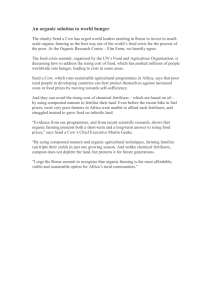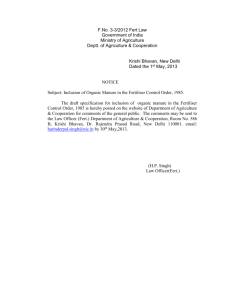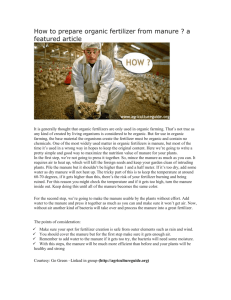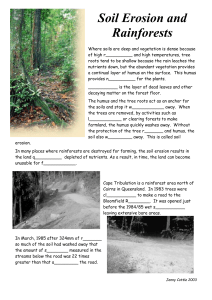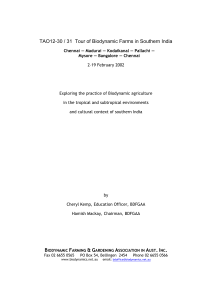Organic and biodynamic cultivation
advertisement
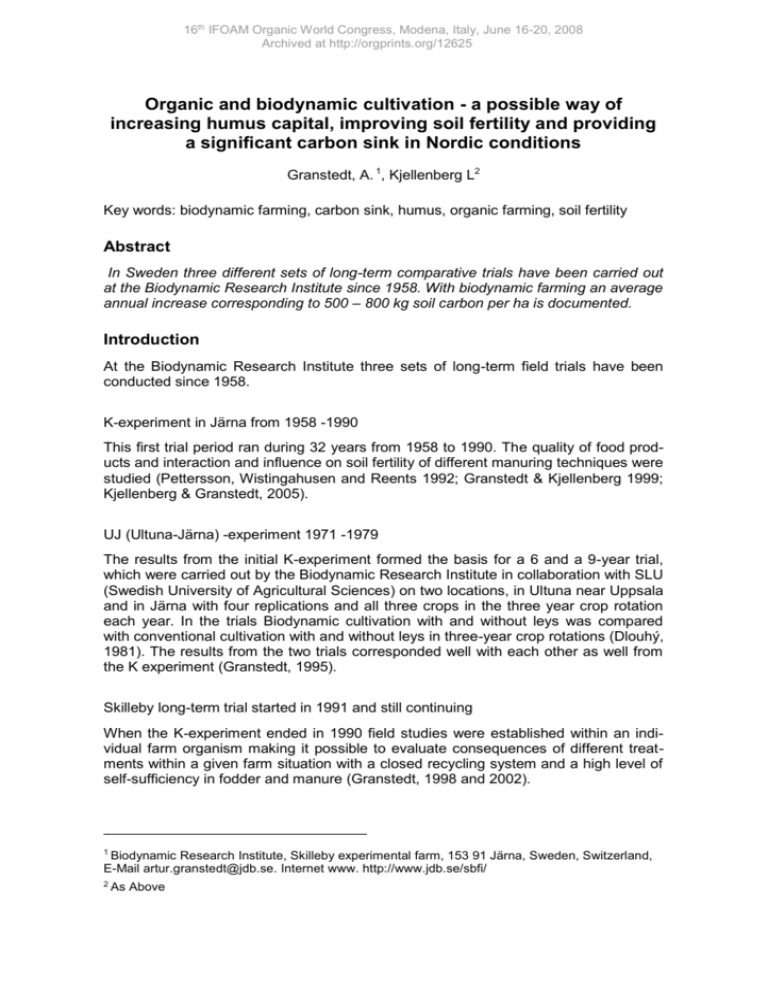
16th IFOAM Organic World Congress, Modena, Italy, June 16-20, 2008 Archived at http://orgprints.org/12625 Organic and biodynamic cultivation - a possible way of increasing humus capital, improving soil fertility and providing a significant carbon sink in Nordic conditions Granstedt, A. 1, Kjellenberg L2 Key words: biodynamic farming, carbon sink, humus, organic farming, soil fertility Abstract In Sweden three different sets of long-term comparative trials have been carried out at the Biodynamic Research Institute since 1958. With biodynamic farming an average annual increase corresponding to 500 – 800 kg soil carbon per ha is documented. Introduction At the Biodynamic Research Institute three sets of long-term field trials have been conducted since 1958. K-experiment in Järna from 1958 -1990 This first trial period ran during 32 years from 1958 to 1990. The quality of food products and interaction and influence on soil fertility of different manuring techniques were studied (Pettersson, Wistingahusen and Reents 1992; Granstedt & Kjellenberg 1999; Kjellenberg & Granstedt, 2005). UJ (Ultuna-Järna) -experiment 1971 -1979 The results from the initial K-experiment formed the basis for a 6 and a 9-year trial, which were carried out by the Biodynamic Research Institute in collaboration with SLU (Swedish University of Agricultural Sciences) on two locations, in Ultuna near Uppsala and in Järna with four replications and all three crops in the three year crop rotation each year. In the trials Biodynamic cultivation with and without leys was compared with conventional cultivation with and without leys in three-year crop rotations (Dlouhý, 1981). The results from the two trials corresponded well with each other as well from the K experiment (Granstedt, 1995). Skilleby long-term trial started in 1991 and still continuing When the K-experiment ended in 1990 field studies were established within an individual farm organism making it possible to evaluate consequences of different treatments within a given farm situation with a closed recycling system and a high level of self-sufficiency in fodder and manure (Granstedt, 1998 and 2002). 1 Biodynamic Research Institute, Skilleby experimental farm, 153 91 Järna, Sweden, Switzerland, E-Mail artur.granstedt@jdb.se. Internet www. http://www.jdb.se/sbfi/ 2 As Above 16th IFOAM Organic World Congress, Modena, Italy, June 16-20, 2008 Archived at http://orgprints.org/12625 Materials and methods K-experiment The long-term K field trial was run with one crop rotation without replications but with each crop each year from 1958 – 1990: 1) Summer wheat, 2) Ley with legumes, 3) Potatoes and 4) Beets The 8 different treatments include: K1-Biodynamic (BD) composted manure and BD field preparation; K2-Biodynamic composted manure without the BD field preparation; K3-Raw farm yard manure; K4- Raw farm yard manure and mineral fertilizer (NPK); K5-No manure or fertilizer; K6- Low mineral fertilizer (NPK); K7-Medium mineral fertilizer (NPK); K8-High fertilizer (NPK). Potatoes and beets were fertilized in the organic treatments and potatoes, beets and wheat were fertilized in the mineral fertilized treatments. The average annual amount of NPK per ha in the composted stable manure in K1 and K2 was averaged for the whole period to 80/38/76, in the not composted manure in K3 to 95/32/91. These amounts corresponded to the possible production of fodder-crops in the crop-rotation and with an animal density of 0,9 animal unit per ha. The average annual amount of NPK per ha in the combined organic and mineral fertilized treatment K4 was 62/24/66, in the mineral fertilized treatments K6 29/18/41, K7 58/36/81 and in K8 117/36/81. The composted manure (30 ton per ha to potatoes and 45 ton per ha to beets) applied in K1 and K2 had lost about 10 % of its biomass and 18 % of its nitrogen content during the composting process before being applied in the field compared to the raw manure applied in K 3. UJ-experiment The Biodynamic Institute in Järna and the Swedish University of Agricultural Sciences (SLU) Ultuna collaborated to compare biodynamic cultivation with (B2-Summer wheat, Ley with clover/grass, Potato) and without leys (B1-Summer wheat, Barley, Potato) with conventional cultivation with (A2-Summer wheat, Ley with clover/grass, Potato) and without leys (A1-Summer wheat, Barley, Potato) in three-year crop rotations. The Biodynamic trials B1 and B2 received biodynamic composted stable manure in an amount comparable to the fodder crop’s manure production (0.7 animal units per ha) while the conventional trials A1 and A2 received mineral fertilizers comparable to what was at that time the recommended standard amounts for these crops (an average of NPK 95/45/110 kg/ha). The trial B2 corresponded to standards for biodynamic cultivation with animal production and A1 the standards for conventional specialized cultivation using artificial fertilizers without animal production. Skilleby long term trial The effects of applications of non-composted and composted manure in the long term experiment were studied, with and without biodynamic preparation treatments, at three levels of application (12.5, 25 and 50 tons per ha 1991-1995 and 0, 25 and 50 tons per ha 1996-1997), 12 treatments with 2 – 4 replications of each crop and established on each of five fields in the five-year crop rotation: oats with under sowing, ley I, ley II, ley III and winter wheat with the application of farmyard manure. This crop rotation was designed to improve the humus content and soil fertility (Granstedt, 1992). 16th IFOAM Organic World Congress, Modena, Italy, June 16-20, 2008 Archived at http://orgprints.org/12625 Results and discussion In the thirty year long K-experiment after the first ten years the yields in the biodynamic (K1) and conventional (K8) fertilized system were on the same level. The treatments with organic manure (K1–K4) combined with the clover/grass ley gave a clear increase of carbon in the topsoil (K1 from 2.4 % to 2.9 % from 1958 to 1989, i.e. an increase of 20 % during 29 years). The annual support of carbon was here 1640 kg per ha and year (Reents, Pettersson & Wiestinghausen, 1992). Samples of organic carbon were also taken at 25 – 35 cm and 50 - 60 cm depth in the soil profile both 1989 and 1985 and at 25-35 cm 1976 (not shown here). Even the organic treatment without all biodynamic preparation treatments gave a carbon accumulation but with lower values with consideration of data with humus content deeper in the soil. The mineral fertilized treatments and the unfertilized treatment gave no increase of the carbon and humus content despite the inclusion of leys in the crop rotation. The total amount of organic carbon to a depth of 60 cm, after interpolation of the humus content in the soil layers between them, can be calculated to 160 ton per ha in the biodynamic treatment (K1), 146 ton per ha in the organic raw manure treatment, and 135 ton per ha in the mineral fertilized treatment. This means that there has been an annual average increase or assimilation of organic carbon in the order of 800 kg per ha in the biodynamic treatment K1 and 300 kg per ha in the organic treatment. This amount is comparable to what is reported from the renowned Rhodale long term experiment from 1981 to 2005 in Pennsylvania in USA in a more legume based farming system with farm yard manure, Soya beans and clover/grass ley (Hepperly, Douds & Seidel, 2006). Our results also correspond with the DOK experiment in Switzerland where the effect of BD preparation and composted manure are also reported (Mäder et al, 2002). UJ-experiment The trial stages B2 and A2 make it possible to analyze the importance of leys in each system. The effect on the amount of humus and carbon in the soil in each system is presented below. The humus concentration in the biodynamic trial with ley increased from 2.72% to 3.06% (1.58 to 1,77 % C-org) during the 8-year trial period (slightly more than 10%) while the humus concentration remained at the same level in the trial with conventional cultivation (Figure 1). Figure 1: Trials comparing biodynamic and conventional cultivation in Järna 1971 – 1979. 1,8 B2 L+FYM 1,75 B1 Corg - % 0-20cm A2 1,7 A1 1,65 FYM 1,6 L+MinF Min 1,55 In these trials the importance of leys and organic fertilizer for the assimilation of carbon in soil and the building up and maintenance of the humus content in the soil and with this the associated biological soil properties is apparent (Dlouhý 1981, Granstedt and Kjellenberg 1999). In this experiment the effect of specific BD was not possible to evaluate. 1,5 Skilleby long term trial 1,45 1971 1973 1976 1979 During the 9 years from 1991 to 2000 the average soil organic carbon increased by 9 % from 2.18 to 2.38 %. This significant 16th IFOAM Organic World Congress, Modena, Italy, June 16-20, 2008 Archived at http://orgprints.org/12625 average increase in the 20 cm topsoil was calculated to 4450 kg C ha-1 from a level of 47850 to 52300 kg C ha-1. Based on data from this study and field experiments with clover grass leys on Skilleby (Granstedt and Bäckström, 2000) it is calculated that a three-year clover grass ley with an annual nitrogen fixation between 100 – 200 kg N ha-1 can result in the net assimilation of 18 tons of carbon in soil biomass. Conclusions Humus degradation can be compensated directly through the incorporation of harvest residues from grassland into the soil and indirectly through recycling farmyard manure derived from fodder produced within the farming system. Both carbon and nitrogen management are key components in these transformations. In biodynamic farming the rebuilding of humus is further developed through composting techniques of manure combined with the use of biodynamic preparations. The importance of leys combined with the recycling of manure from the animal husbandry within the farming system is seen. Organic and biodynamic farming has the capacity to be an important carbon sink to reduce the surplus of carbon dioxide in the atmosphere. References Dlouhý, J. (1981): Alternativa odlingsformer – växtprodukters kvalitet vid konventionell och biodynamiska odling. Rapport 91, Inst. f. växtodling. Swedish University of Agricultural Sciences. Granstedt, A. (1995): Long term field experiment in Sweden (K-Trial). Effects of organic and inorganic fertilizers on soils and crops. Fertilization, crop yield and quality. Raupp, J. 1995 (ed.). Concerted action supported by the European Community: Fertilization Systems in Organic Farming. Pp. 16–21. Publ. Institute for Biodynamic Research. Darmstadt. Granstedt, A. (2002): Use of Livestock Manure in Ecological Agriculture: Results from Field Experiments in Winter Wheat on Skilleby, Järna, Sweden 1991–1997. 14th Organic World Congress, Victoria, Canada. August 2002 Granstedt, A., L-Baeckström, G. (2000): Studies of the preceding crop effect of leys in ecological agriculture. American Journal of Alternative Agriculture, vol. 15, no. 2, pages 68–78. Washington University. Granstedt, A., Kjellenberg, L. (1999): Long-term field experiment in Sweden: Effects of organic and inorganic fertilizers on soil fertility and crop quality. In: Proc. International Conference on Agricultural Production and Nutrition, Boston. Hepperly, Douds, Seidel, (2006): The Rodale Institute Farming Systems Trial 1981 to 2005. In Raupp, Pekrun, Oltmanns and Köpke. Long Term Field Experiments in Organic Farming. ISOFAR Scientific Series. Berlin Mäder, P., Fliessbach, A., Dubois, D., Gunst,L., Fried, P., & Niggli, U. (2002). Soil Fertility and Biodiversity in Organic Farming. Science VOL 296 pp 1592-1597. Pettersson, B. D., Reents H. J. & Wiestinghausen E. v. (1992): Düngung und Bodeneigenschaften, Ergebnisse eines 32 –jährigen Feldversuches in Järna. Schweden. (In German with English summary) Nordisk Forskningsring, Meddelande nr. 34, Järna, Sweden. Online-Document: Kjellenberg, L. & Granstedt, A. (2005): The K-trial. A 33-years study of the connections between manuring, soils and crops. Biodynamic Research Institute, Järna, Sweden. (http://www.jdb.se/sbfi/publ/k-trial.pdf)

